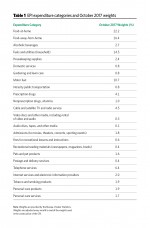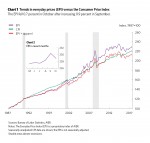Everyday Prices Excluding Energy Rise Just 0.1 Percent in October
AIER’s Everyday Price Index fell 0.7 percent in October following a 0.9 percent gain in September. Large swings in energy prices were the primary driver for the September spike and October retreat. The EPI measures price changes people see in everyday purchases such as groceries, restaurant meals, gasoline and utilities. As a comparison, the more widely known price gauge, the Consumer Price Index, which is reported by the Bureau of Labor Statistics and includes less frequently purchased items, fell 0.1 percent in October. The EPI is not seasonally adjusted, so we compare it with the unadjusted CPI.
The EPI including apparel, a broader measure, dropped 0.6 percent in October as apparel prices rose 0.1 percent for the month. The EPI and the EPI including apparel exclude prices of infrequently purchased, big-ticket items (such as cars, appliances and furniture) and prices contractually fixed for prolonged periods (such as housing).
Over the past 12 months, the EPI has risen 2.0 percent while the EPI including apparel is up 1.8 percent. For the same period, the CPI is up 2.0 percent. Over the last five years, the EPI is unchanged, compared to an average rise of 1.3 percent for the CPI.
Energy prices tend to be volatile and are a major component of the EPI. Therefore, energy-price moves often drive short-term movements in the overall EPI. Motor fuels fell 5.4 percent in October on a not seasonally adjusted basis following a jump of 10.6 percent in September. Household fuels and utilities also posted a decline, dropping 1.9 percent, the third decline in a row. Combined, the drops in motor fuel and household fuels and utilities more than accounted for the 0.7 percent decline in the overall EPI. Excluding both energy categories, the EPI was up 0.1 percent for the month.
On a year-over-year basis, the EPI excluding energy is up 0.6 percent. October is the 31st consecutive month below 1 percent, measured on a year-over-year basis, and the 68th consecutive month below 2 percent.
Among the components of the EPI, 14 of the 24 categories were up in October while 10 were down. Among the components with the largest weights in the EPI, food at home (22.2 percent weight) is up 0.6 percent from a year ago and up at a 0.6 percent annualized rate over the past 5 years, food away from home (16.4 percent) is up 2.3 percent over the last 12 months and 2.5 percent over the last 5 years, household fuels and utilities (14.5 percent) are up 2.8 percent for the year and 1.7 percent over 5 years, and motor fuel (10.7 percent) is up 10.8 percent since last October but down 7.5 percent annually since 2012. Combined, these top four categories account for 63.9 percent of the EPI.
The key take-away is that broad-based increases are still not present in everyday prices: some areas have seen outright price declines over the past year and the past five years, some are seeing modest price increases and some are experiencing persistent, sizable increases.







